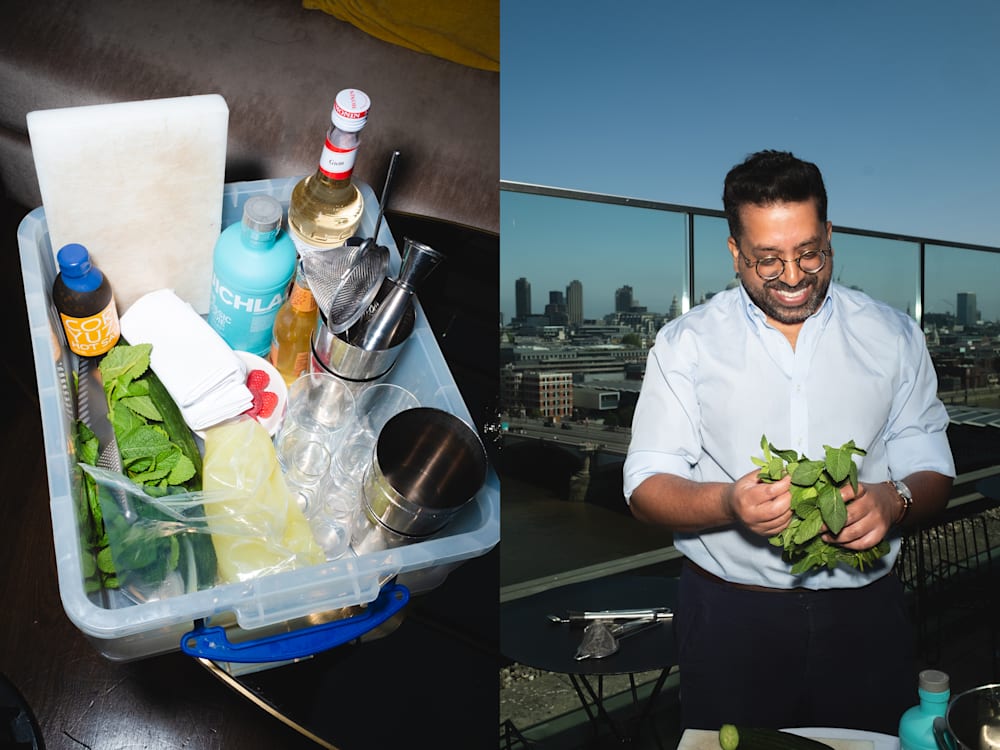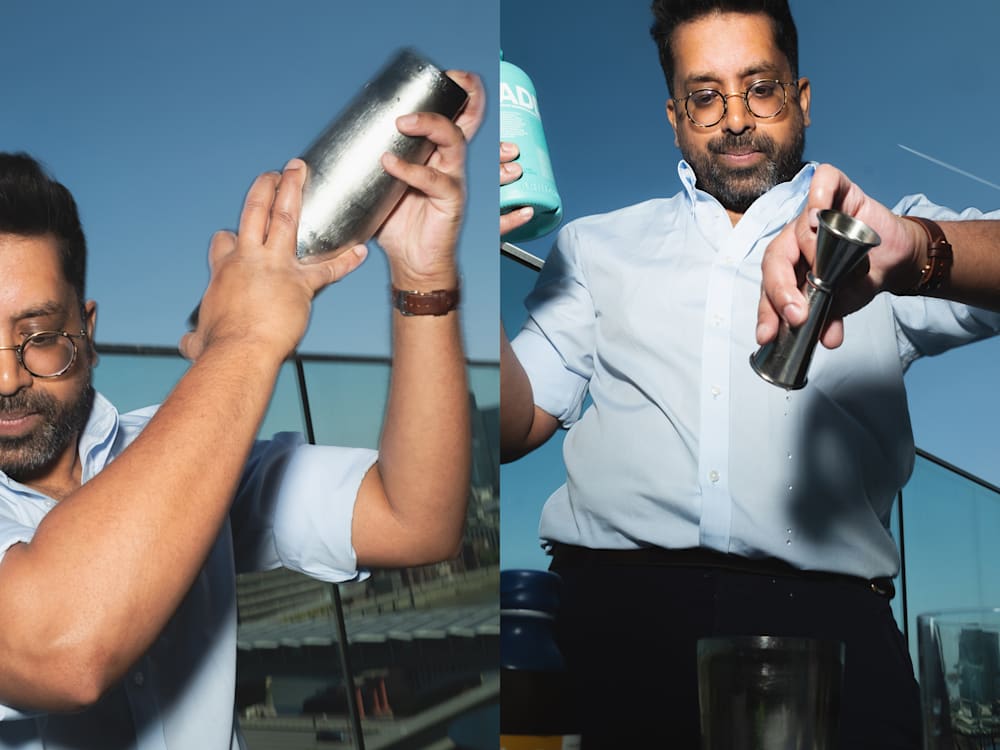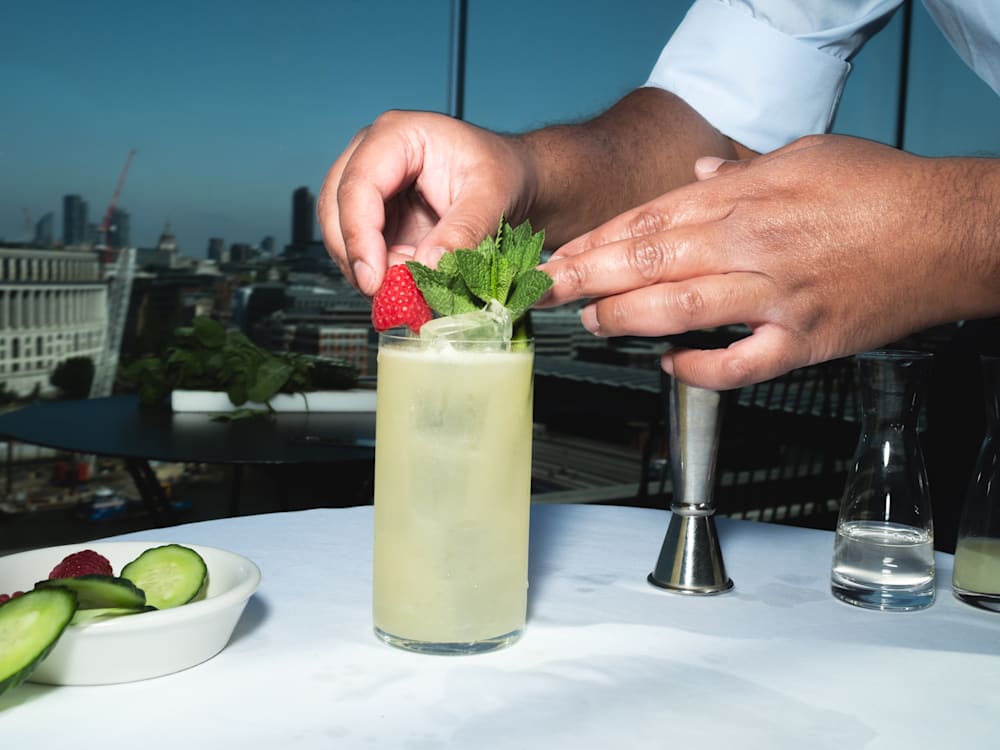What’ll it be? Well, it seems bar star Ryan Chetiyawardana (better known as Mr Lyan) will have one of everything. The high priest of mixology must have filled several mantlepieces with his collection of awards, from World’s Best Bar to Most Influential Londoner and a host of best bartender gongs, and juggles various occupations: author, teacher, consultant, custom-spirit crafter…
His drinks lists — at renowned London hotspots Lyaness, Seed Library and more around the world — are equally diverse, mixing his know-how in fine art, biology and philosophy with a thirst for innovation and a keen sense for flavour pairings, many on the mad-scientist side of creation. We sat down with the mover and (cocktail) shaker to talk innovations in sustainability, his work with industry greats, and where to get a good drink, wherever you are.

What inspired you to start your first bar venture? And why did you choose to launch in East London?
Having run venues for other people for some time, I was excited to show that the landscape of venues could be wider. [My first bar] White Lyan was the original plan; we knew it could be a loud way of making this point (mainly as it was drastically different to what else was out there), but it was also developed in tandem with Dandelyan, and our desire to have venues with diverse expressions.
Opening in East London was very purposeful; as a creative area, we knew we could attract a wide audience that was excited by new ideas — not just the established cocktail set.
You’ve been a pioneer in sustainable mixology — famously doing away with perishable ingredients and even ice. Which new innovations ensure your bars run in environmentally conscious style?
‘Good Things’ was a founding principle of the brand, and we knew we wanted to apply this idea of doing good in a wide manner, and across a series of projects. Having done a series of lectures and pop-ups on food sustainability in 2011, we knew we could challenge the idea of what the intersection of luxury and waste could look like in the food world.
White Lyan (and Hoxton’s Cub restaurant) pushed these ideas to the extreme, but since that early focus on waste, via human sustainability and trying to understand the chain we can affect, we’ve tried to see where we can influence excitement and [generate] ideas around the topic across our venues. It’s amazing to see bars and restaurants across the world take on the mantle of material and energy usage, but we’ve also tried to see how we can affect change by speaking with, working with and learning from larger institutions and governmental bodies to try and create a much greater systemic change.

From pre-mixing drinks so bartenders can interact with guests to tightly curated playlists, you’ve fine-tuned the ambience of your bars. What’s the secret to making a space as inviting as possible?
We try to look at the experience in a holistic way. Our teams are the best in the world, and they show warmth and hospitality to every guest in a manner that really makes the spaces feel special. But of course, the cocktails, style of service, music, language and communications, lighting and the design (we’ve worked with architect Jacu Strauss and his team across all the venues on the spatial design, and Magpie Studio on our graphic identities) are all key tools in making the venues as special as possible.
There are great examples around the world, too: Caretaker’s Cottage in Melbourne, Alquímico in Cartagena, Native in Singapore, Sip & Guzzle in New York — even old style venues like La Venencia in Madrid – all have their own voice and an exciting personal interpretation of hospitality.
If you could choose to see one person sitting at your bar, who would it be?
I would have loved to serve and chat with David Bowie. He would’ve been an amazing person to make a drink for; his constant embrace of innovation and his focus on celebrating the tribulations of being human — in all senses — have been very inspirational for me.

Storytelling plays a huge part in your creative process. Are there any particular tales from your travels that have inspired your cocktail creations?
Storytelling is our way of making the complex world of taste as accessible to people as possible. It also allows our team to really channel their diversity and creativity [into their work]. The beauty of this approach is that stories come from everywhere, so inspiration can be gathered from everyone and any little observation.
I’ve loved seeing the different ways people gather, celebrate and connect all around the world, so I find every bit of travel fascinating, and this has informed the work in the bars, through to the work we’re doing with my show Mr Lyan’s Taste Trips. But there have also been wonderful little anecdotes that have become part of the bars: for example, a trip to Hart Bageri in Copenhagen where we learnt from baking legend Rich Hart and saw him simplify a previously laborious process into one deft movement: there’s this established thinking that you have to do complicated folding and kneading, taking the proofed bread out before the next resting (Rich, forgive me if I’ve butchered this order!). But he simply picked up the soft dough, did one little twist and tuck, and put it to rest snug in the [basket]. It channelled the mastery of his wealth of expertise, and his sheer love for a product, into something that exemplified the marriage of art and science perfectly, and it inspired a cocktail for a drink on the Lyaness menu.

What are the top three hotel bars you’ve visited on your travels?
I love the Pulitzer Amsterdam hotel; being able to sit at the bar there and feel the balance of old and new that both the city and the hotel are just so good at evoking.
On a recent visit to Cape Weligama in Sri Lanka, being immersed in nature, watching the ocean as coconut palms swayed in the breeze and I sipped arrack with some dear friends, was magical.
I already thought Kyoto was the most beautiful city in the world, but being able to drink tea at the Aman hotel there, overlooking the forest and the spring colours, was even more breathtaking than I could have imagined.
Which city around the world do you think has the most vibrant drinking scene?
Without a doubt, London has the best food and drink scene in the world. The reason it has remained so strong is the diversity of the city. The depth and variance [in ingredient offerings] and focus on excellence this brings is unmatched anywhere else, even though it’s become harder to maintain this in recent years. In short, Brexit and a lack of respect from governments for what our industries bring not only to the economy (creative arts are our biggest export!), but to culture — especially in a time where one of the biggest issues of modern society is an isolation epidemic. It is harder for us to attract the staff, investment, produce and talent we need with these restrictive outlooks.
You recently launched a range of cocktail seasonings called Three Families, inspired by your Sri Lankan heritage. Which other countries have influenced your work?
Three Families was born from my wonder of the ingredients and customs I found in Sri Lanka, and conversations I had with friends who had struggled to use those fruits and spices, as seasonality, consistency in quality and price got in the way.

But I also loved the attention to detail I found when travelling around Japan, and how they really hone in on one very clear proposition. There’s a very old knife shop [in Japan] I’ve been using for over a decade that specialises in a specific type of blade and has done for over 200 years. You’ll also find someone who has dedicated their passion to making [one type of food] and dedicate all their craft and passion into continually perfecting that one thing. And seeing the ancient ingredients and the sense of connection to place in Colombia, Mexico and Australia.
You’ve worked with the likes of Whitebox and Bébé Bob. Who would be your next dream collaborator?
So many dream collaborators! We’ve loved working with people and brands in the fashion and music worlds, as well as some of the adjacent expertise we’ve had support from: ‘flavour scientist’ Dr Arielle Johnson; microbiologist Dr Rachel Dutton; cutting-edge chef Dr Johnny Drain; food-science writer Harold McGee; and spirits expert Dave Broom.
I would love to build on the work we did with the Noma Projects team, and I’d also love to work with a giant of a brand like Marmite, someone with heritage like Omega, or with something very different like Ortiz. And, of course, it’s always great to collaborate with creatives outside the food world.
With bars in London, Amsterdam and Washington DC, how do you adapt menus to provide a sense of place?
Each of the bars has a different feel that really speaks to their location. Of course we adapt local flavours and preferences, but the main difference is the macro focus of the bars, which have all been born of their individual locations. It would be amazing to see some of the concepts be adapted for a different setting — we did an extended New York residency for Lyaness, while Super Lyan was developed out of our research into Amsterdam, and Silver Lyan was created in response to spending time in DC.

Ingredients such as smoked camel milk, jellyfish and cornflake frozen yoghurt show your dynamic, scientific approach to mixology — what’s your creative process?
All of these ingredients could seem gimmicky in isolation, but once you understand their context, and how they’ve been pulled to channel the sentiments of a story, they start to make much more sense! We do this by not starting with flavour at all — the team spends about six months researching a wide range of topics, and then we hone and refine them to get to the heart of the sentiment [of the drink], develop the techniques that speak to this, then connect the ingredients together.
What’s your favourite cocktail and bar snack pairing?
A martini and any little bar snacks will forever remain magical to me, but I love a French 75 with some fried chicken.
What’s next for the Mr Lyan brand?
Lots, as always! We love working on new ideas, and hopefully we’ll have some fun things that will begin to materialise soon. We also have new menus dropping across all the bars and some amazing milestones to celebrate — we’ve just had Seed Library’s three-year anniversary, and the fifth anniversary for Silver Lyan is coming up.
Where’s next for a well-earned holiday?
I’m due to do a proper holiday at some stage, but I’ll head over to see my sister in Portugal in a few months, which means I can spend some time with the family, and get a bit of coastal sunshine!

Did someone say happy hour? Learn how to make a Corn Yuzu Highball — a twist on Seed Library’s Corn Yuzu Mule — with Mr Lyan’s step-by-step recipe.
Corn Yuzu Highball
Ingredients
– 1cm slice of cucumber, plus more to garnish
– 5ml Noma Projects Corn Yuzu hot sauce, to taste (can be substituted for Tabasco or ponzu)
– 15ml sugar syrup
– 20ml freshly squeezed lime juice
– 50ml Bruichladdich Classic Laddie (or your favourite fruity single malt or spirit)
– 50ml Fever Tree ginger ale, chilled
– Mint sprig, cucumber slice and raspberry to garnish
You will need
– Cubed ice
– Shaker or lidded jam jar
– Hawthorne strainer
– Fine strainer
– Highball glass
Method
Crush a slice of cucumber in the bottom of a shaker (or a jam jar that seals well), then add the sugar syrup, hot sauce, lime and whisky. Fill the shaker with cubed ice, seal, then shake well. Fill your highball with fresh cubed ice then double strain, pouring the strained cocktail through a fine strainer to remove any ice shards and fruit pulp. Add more ice to your glass, then top with the chilled ginger ale. Garnish with spanked mint, a slice of cucumber and a raspberry, and serve.
Thirsty for more? Nab a seat at the best hotel bars in London, Paris and New York
Photography by Charlie Kwai



